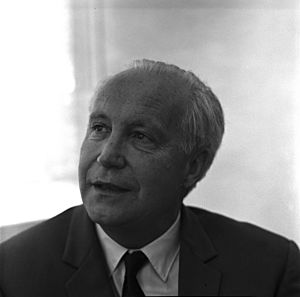Willibald Jentschke facts for kids
Quick facts for kids
Willibald Jentschke
|
|
|---|---|

Willibald Jentschke at CERN
|
|
| Born | 6 December 1911 |
| Died | 11 March 2002 (aged 90) Göttingen, Germany
|
| Occupation | Austrian physicist and former CERN Director-General |
Willibald Jentschke (born in Vienna, Austria-Hungary, on December 6, 1911 – died in Göttingen, Germany, on March 11, 2002) was an Austrian-German scientist. He was an experimental nuclear physicist, which means he studied the tiny parts inside atoms through experiments.
During World War II, he worked on a project related to nuclear energy in Germany. After the war, he moved to the United States. There, he worked at Wright-Patterson Air Force Base in Ohio.
In 1950, he became a professor at the University of Illinois at Urbana-Champaign. A year later, in 1951, he became the director of the Cyclotron Laboratory there. A cyclotron is a special machine that speeds up tiny particles.
In 1956, he became a physics professor at the University of Hamburg in Germany. He led the effort to build a large particle accelerator called DESY. He was the director of DESY for 10 years. Later, in 1971, he became the Director General of CERN Laboratory I for five years. CERN is one of the world's largest and most respected centers for scientific research. He retired from the University of Hamburg in 1980.
Early Life and Learning
Willibald Jentschke studied physics at the University of Vienna from 1930 to 1936. He earned his doctorate degree in 1935. His main teacher was Georg Stetter.
His Work as a Scientist
From 1937 to 1942, Jentschke was a teaching assistant at the University of Vienna. He helped Georg Stetter with his classes. From 1942 to 1945, he taught at the University of Vienna. During World War II, he was also a scientific assistant at the Second Physics Institute of the University of Vienna. This institute worked on studying new elements and measuring nuclear properties. This work was part of a German project related to nuclear energy.
In 1939, scientists John Archibald Wheeler and Niels Bohr suggested a model for how atoms split. This idea helped explain that a type of uranium (uranium 235) was important for nuclear fission. Jentschke and his colleagues also confirmed these ideas. They observed a similar effect in an isotope of thorium, which is another element.
After World War II, many German scientists moved to other countries. Jentschke moved to the United States in 1947. He worked at the Air Force Materiel Command at Wright-Patterson Air Force Base in Ohio. He wanted to do important scientific work, which was difficult in Austria and Germany at that time.
In 1950, Jentschke became a professor at the University of Illinois at Urbana-Champaign. In 1951, he became the director of the Cyclotron Laboratory there. This lab used a cyclotron to study tiny particles.
In 1956, Jentschke became a professor of physics at the University of Hamburg. He wanted to build a new research center around a particle accelerator. A particle accelerator is a machine that makes tiny particles move very fast. This helps scientists learn about the basic building blocks of the universe.
His idea for a new accelerator was supported by the German government. On December 18, 1959, the Deutsches Elektronen-Synchrotron (DESY) was founded. It was a large electron synchrotron that could accelerate particles to 7.5 GeV. Jentschke was the chairman of the DESY Board of Directors from 1959 to 1970. He also directed the Second Institute of Experimental Physics at the University of Hamburg for many years. At DESY, he supported building another accelerator called DORIS. He also promoted using synchrotron radiation for research. This is a special type of light produced by fast-moving particles.
In 1971, Jentschke became the Director General of CERN Laboratory I. CERN is a very famous research center in Europe. He worked alongside John Adams, who was Director General of CERN Laboratory II. They led CERN until the two laboratories joined together in 1976. During his time as Director General, Jentschke oversaw the use of a new research tool called the Intersecting Storage Rings, which started working in 1971.
Jentschke retired from the University of Hamburg in 1980.
Awards and Recognition
Professor Jentschke received many awards for his important work:
- He received the Wilhelm Exner Medal in 1971.
- He was a member of the Akademie der Wissenschaften und Literatur in Mainz, Germany.
- He was a corresponding member of the Österreichische Akademie der Wissenschaften in Vienna.
- He received honorary doctorates from the University of Illinois at Urbana-Champaign and RWTH Aachen (in 1990).
- He received the John T. Tate Award from the American Institute of Physics in 1996.

